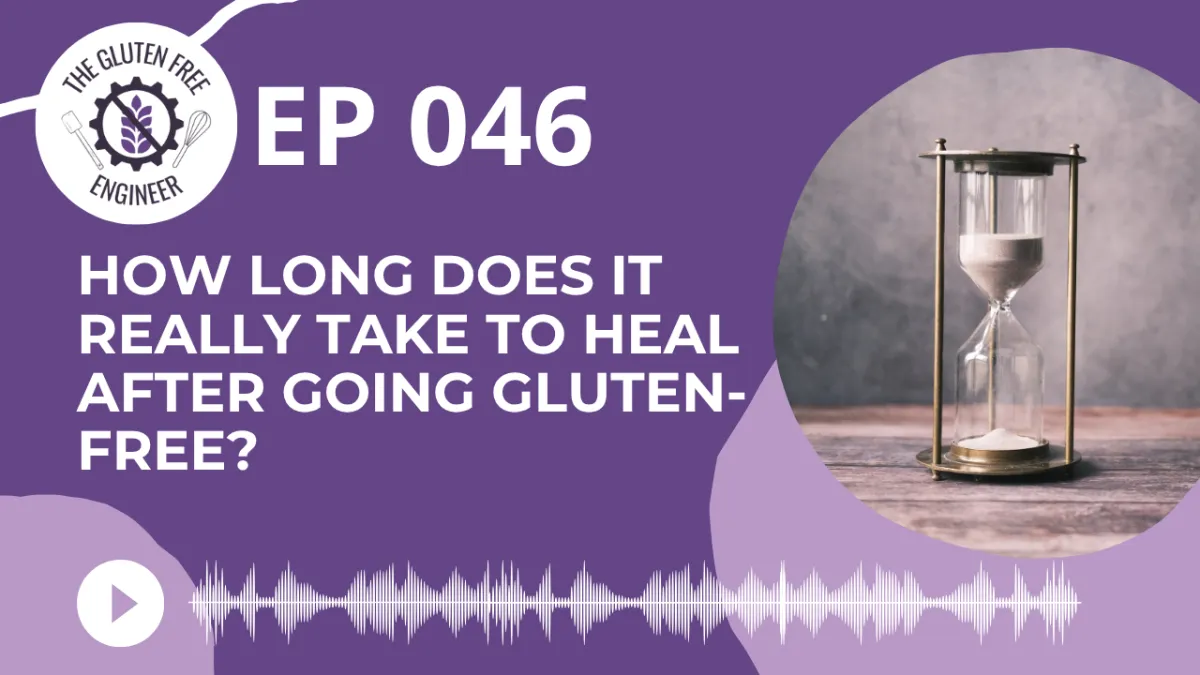
#46: How Long Does It Really Take to Heal After Going Gluten-Free?
If you’ve just gone gluten-free, you might be wondering — how long does it actually take to feel better? Is it days, weeks, or months?
Healing looks different for everyone, and it’s not always a straight line. In today’s episode, I’ll break down what happens in your body after removing gluten, what kind of improvements you can expect and when, and how to tell if your healing is on track.
Let's Recap: How Long Does It Really Take to Heal After Going Gluten-Free?
The First 30 Days: Your Body Begins to Recalibrate
Cutting gluten triggers more than a pantry cleanout; it starts a full-body recalibration that almost never moves in a straight line. During the first month, inflammation begins to settle, but the process can feel bumpy. Many people notice early improvements like less bloat, clearer thinking, and steadier energy. Others experience swings in digestive symptoms as the gut adjusts.
As the microbiome shifts and the bugs that once thrived on wheat-based foods lose their fuel, cravings and irritability can show up. You might even feel a withdrawal-like slump. Try to view these changes as a temporary transition rather than a setback. Your body is rebalancing long-held patterns shaped by years of gluten exposure.
Weeks 3 and 4: Clarity Starts to Break Through
By the third and fourth weeks, positive changes often become easier to see. Brain fog lifts for many people, allergies start to calm as inflammation drops, and energy may feel cleaner and more stable.
Not everyone moves through this phase in a perfect upward curve, but many describe a moment when things suddenly feel sharper and more peaceful. Digestion may still need time to catch up. Motility, enzymes, and bile flow often take longer to normalize. Consistent routines, hydration, sleep, gentle movement, and simple whole foods give your system the support it needs to keep progressing.
Months 3 to 6: Deeper Repair Begins
From three to six months, structural healing takes center stage. The intestinal villi begin to regenerate in people with celiac disease, improving nutrient absorption. Levels of iron, vitamin D, B12, folate, and calcium can rise as malabsorption eases, as long as the diet supplies them and gluten exposure stays tightly controlled.
This is also when accidental gluten hits may feel more intense, but recovery times usually shorten as habits improve and your kitchen and shopping systems become safer. Emotional steadiness often returns too, as inflammation-related irritability and mood swings settle.
Months 6 to 12: Feeling Like Yourself Again
Between six and twelve months, most people feel significantly better. Digestion steadies, skin clears, energy lasts longer, and joint discomfort often fades. For those with celiac disease, antibody numbers typically drop as the immune response cools.
Some lingering fatigue or aches can persist, especially in cases of late diagnosis, other autoimmune conditions, or inconsistent adherence. The guiding principle holds true here. The more consistently gluten-free you are, the faster your system rebuilds. Over time, the contrast between feeling unwell and feeling well makes long-term adherence much easier.
One Year and Beyond: Long-Term Maintenance
After a year, the focus shifts to maintaining your progress without slipping into complacency. Full villi recovery can take one to two years for some people, and not every change reverses completely. That is why strict gluten avoidance remains essential.
Think of gluten as a high-stakes trigger. Just as you would not deliberately test an allergy, you should not test gluten exposure. Build weekly rhythms around nourishing meals, stress management, and routines that protect your gut. Keep periodic labs to confirm nutrient replenishment and address any gaps. When setbacks occur, respond with calm and clarity, then return to what works.
How to Track Your Progress
Tracking is one of the most underrated tools in healing. A simple food and symptom journal helps you see patterns that memory alone cannot capture. Identify which meals feel best, which exposures slow progress, and how mood and energy shift over time.
Celebrate non-scale victories like clearer skin, better sleep, and calmer mornings. Pair your observations with labs for iron, vitamin D, B12, and folate to confirm that progress is happening physiologically, not just emotionally. Most importantly, give yourself grace. Healing rarely follows a straight line, but with consistent habits and the right support, it moves you steadily back toward feeling like yourself again.
